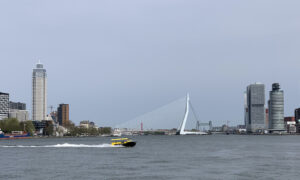If you’re feeling inspired by teen environmental activist Greta Thunberg, Luggagehero.com has some helpful suggestions for you. The 16-year-old recently sailed from her home in Sweden instead of flying to New York for the United Nations Climate Action Summit on 23 Sept. (Youth Climate Summit is Sept. 21).
Greta is the current face of “flygskam,” or “flight shame,” a growing movement in Europe and North America to reduce air travel in order to lessen impact on the environment. Burning jet fuel releases greenhouse gases such as carbon dioxide into Earth’s atmosphere and oceans, which causes global temperatures to rise.
Worldwide, flights produced 895 million tons of CO2 in 2018, while humans produced over 42 billion tons, according to the the Air Transport Action Group. Overall, the aviation industry is responsible for around 2 percent of human-made carbon dioxide emissions, according to the International Air Transport Association.
Those emissions can have a devastating impact on our environment. With air traffic rapidly growing, the damage is sure to multiply. But it’s not too late to improve the situation.

Here are some tips to lower your carbon footprint while still getting the most out of your travels.
Remember: Every bit helps!
Avoid short hops
For instance, if you are traveling from Paris to London and choose road transportation over flying, you’ll cut your carbon dioxide emissions by more than half. •
Your portion of CO2 emissions on a flight between the two cities would total 122.1 kilograms, while driving would be 48.4 kilograms and train travel 14.4.**
Energy-wise, trips below 965 kilometers (600 miles) are said to be more efficient with a train, bus or driving.
Say yes to nonstop
Flying nonstop saves a lot of energy because takeoffs and ascent require significantly more energy than cruising at altitude. In fact, around 25 percent of the fuel used is consumed during takeoff. Once at cruising altitude, the plane becomes much more fuel-efficient. Think of it this way: Changing planes is double the trouble.
But also avoid long flights
For fuel efficiency, the best flight length is about 3,000 miles (4,828 kilometers). Longer flights need more fuel, which makes the aircraft heavier and less efficient, thereby increasing its carbon footprint per mile.
Or just slow it down
Take fewer flights and stay longer on the ones you do take. Side benefit: You get to know a place better. Isn’t that what travel is all about?
Use green airports when possible
What makes an airport green? Things like their recycling programs, sustainable building design, reduction of noise pollution and emissions control for airport vehicles. Airports recognized for their environmental efforts include Boston Logan International Airport, Zurich Airport, and East Midlands Airport in England.
Choose the economy section
The more people on a plane, the more efficient the energy use becomes. You can pack more passengers into coach, while business and first class give fliers more space, so thereby hold fewer bodies. Upgraded sections also have heavier seats, allow more luggage and use more service items.
Pack lighter
The more your baggage weighs, the more the plane has to carry and the less energy efficient it is. So keep your stuff to a minimum, which is more convenient anyway.
Refuse or reuse plastic
Don’t use plastic when you’re in the airport or on the flight. That includes straws, stirrers and cups. If you do take a plastic up on the flight, reuse it. You could even bring your own meal, foregoing all the plastic parts to an airline meal.
Patronize travel companies that offset carbon
Some tour providers routinely offset carbon. Look for companies that mitigate both the impact from their travelers and their own business operations.
Sign up for a carbon offset plan
Nonprofit carbon offset programs allow you to purchase a carbon offset equivalent to how much carbon your flight costs. In this way, you pay money into a project that attempts to save energy and emissions elsewhere. Examples are planting trees and subsidizing fuel-efficient cook stoves in Africa. Some airlines also partner with carbon offset programs. When choosing a plan, you’ll want to research the sponsor and where your money is being spent.
Forego flying for a year
Maja Rosén from Sweden is encouraging people to make a pledge to give up flying for one year – 2020. Last year she founded the group We Stay on the Ground to recruit fellow activists. Anyone can join, but a national pledge won’t become official until 100,000 in a country have signed up. Active campaigns are ongoing in Sweden, the United Kingdom, Denmark, Belgium, France, Germany and Canada.
Stay grounded
You can jump totally in by not flying at all, like Greta and others have. Instead, take alternative transportation, such as trains, buses, boats, bicycles and automobiles (even better if you carpool).
Join the movement
Regardless of whether you boycott flying all together, change a few personal habits or make no changes at all, you can still help by advocating for the environment. That could include supporting research and development of greener aviation, pushing for more energy-efficient public transportation and voting for local and national leaders who prioritize climate change. Every bit helps!
DATA SOURCES
* Amadeus IT Group in combination with International Civil Aviation Organization (ICAO) emission factors, compiled by Griffith University Institute for Tourism and interpreted by LuggageHero.
** EcoPassenger, a calculation tool provided by International Railways Union. Calculations for car travel uses 1.5 passengers, for train travel an average load factor, and for airplanes a European average utilization, including arrival and departure and taxing on the airfield.

About LuggageHero.com:
LuggageHero.com is a global network of safe, convenient and affordable luggage storage sites in local shops, cafés, and hotels. It has stored more than 1 million hours of luggage across more than 1,100 drop-off points in Europe and North America.
LuggageHero is headquartered in Copenhagen and serves travelers across 30 major cities in Europe and North America, with a dozen more to be launched this year. LuggageHero was named one of the Top 25 travel startups to watch in 2019 by PhocusWire and has been recommended by leading media outlets, including New York Times, Lonely Planet and CNBC.














